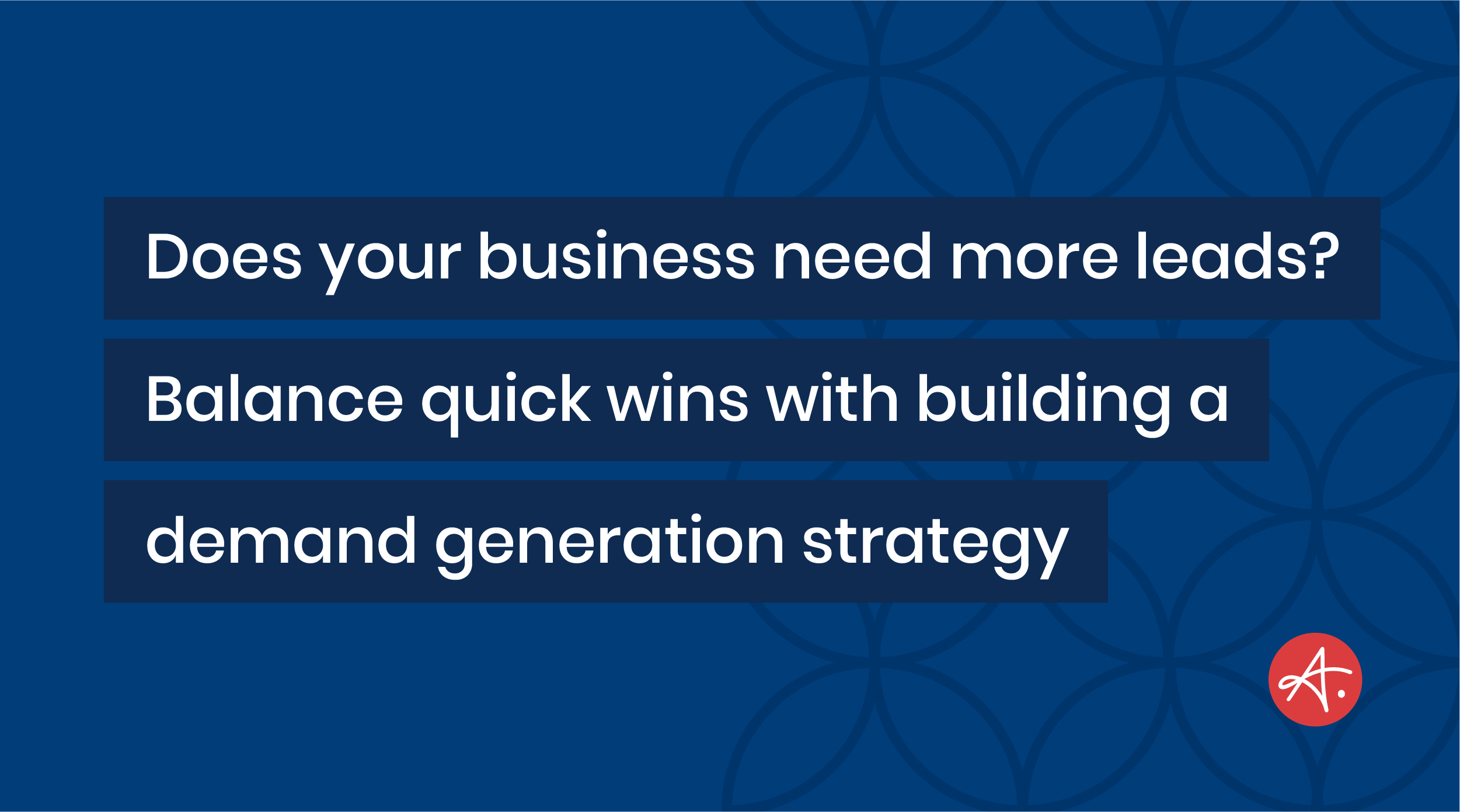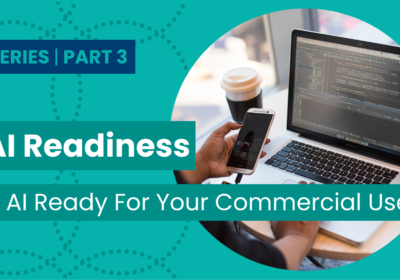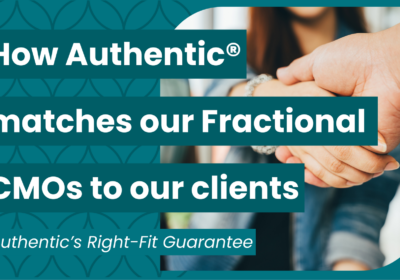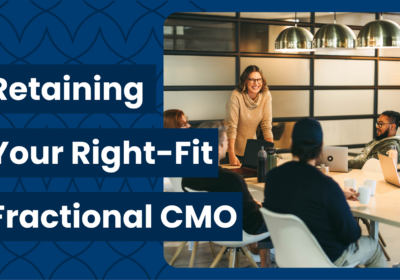
Every growing business wants more leads. In fact, in new client discussions, it’s what businesses are often thinking about most. But, the reality is that companies need strategic demand generation programs in place to drive sustainable, long-term lead creation. While there’s no quick fix to solving all of your demand generation challenges, there are some opportunities that companies can leverage to generate leads quickly in the short term.
We invited several of Authentic’s fractional CMOs and peer advisors, Heather Battison, Kate Hendershott, and Paul Richardson, to weigh in on balancing the short-term need to quickly drive new leads and the long-term need to develop a strategy that results in sustainable, healthy demand.
- Creating sustainable and consistent demand takes time. Why are there no quick fixes for lead generation?
Paul: There are no quick fixes for lead generation for one key reason: People don’t want to be sold to. They want to be in control of their purchases – whether as an individual consumer or when making business purchases. That brings us to the Rule of 7 – which says that a potential buyer will need at least seven touchpoints with your brand before making a purchase. (Seven is probably low; I like to think of this as the Rule of 20).
These touchpoints can be anything from traditional advertisements to blog posts, emails, website visits, sales calls, or perhaps the best, a referral from a trusted colleague. Ultimately, these touchpoints will help the prospective buyer progress from awareness to consideration to exploration to purchase. To generate leads consistently, look at your marketing mix and ensure that you are encouraging conversion at multiple touchpoints.
Kate: Piggybacking on what Paul said, you need to earn people’s attention. Relying on interruption techniques can only take you so far. In fact, when you begin to interject promotions into quick-fix marketing tactics, your customers may start to rely on getting “a great deal” and be reluctant to pay the full price. Your short-term quick fix can derail the hard work you’ve put into building your brand and reputation.
Heather: If it were that easy, you would be doing it already! Not necessarily a quick fix, but there is something to be said for taking a fresh look at your creative (design and copy) to see if it could work harder for you. Sometimes your outreach is spot-on in terms of spend and tactics, but minor tweaks to the look, feel, and content could resonate better with your audience, providing you with a better return.
No matter if it’s an email, landing page, or banner ad, be sure to follow Conversion Rate Optimization (CRO) best practices. Create your benchmark first, document your KPIs for all of your creative, and launch simple A/B tests to see if you can increase output.
- Businesses, at one point or another, may need to ramp up lead generation quickly. Even though there aren’t quick fixes, what strategies or tactics can businesses use to generate more leads quickly in the short term?
Kate: This is a tricky one, as we just conveyed all the reasons why quickly generating leads is not a recommended strategy. However, we understand that sometimes this tactic is needed to keep the lights on and pay the bills. I’d recommend starting down the funnel where you at least have interested parties that are engaged with your brand or have already converted into a customer.
Shift your messaging from an inside-out message to an outside-in message by using:
- Customer testimonials or case studies,
- Words and images that feature real users,
- Facts and results that demonstrate benefits.
You can also add new distribution channels – traditional, social, or digital, but be certain you know where your customer “hangs out.” Lastly is the most obvious but often overlooked tactic; ask for a referral!
Heather: I’ve seen this many times. Someone sounds the panic button, and there is a nervous dash to see an influx of leads/contacts/prospects come through. When there is pressure to generate new leads quickly, it can often amount to a big pool of nothing. To me, it’s not so much about the tactic as it is about who you target.
When the pressure is on, go with who you know. Don’t target everyone and anyone, but spend wisely and focus on the right audience. Who has converted in the past six months? What do you know about them? If you don’t know your customer, that is an entirely different conversation. But rather than casting a wide net that surely will bring in a lot of names but little activity, find folks similar to those who have converted for you recently. Starting with generic demographics is a starting block, but do you know where they go to digest news? Are they heavily populated in certain geographic locations? Getting the RIGHT lead is the goal.
Paul: As Heather noted, it’s best to start with what’s working. Where are your best leads coming from? What do they have in common? From there, explore “look-alike” audiences that might match these attributes. For example, if you have a good source of leads via LinkedIn advertising, consider extending that reach to similar audiences – perhaps other groups within LinkedIn or by using LinkedIn’s partner network.
Another potential source is to ask your best customers for referrals. One of the best ways they can support your business is by introducing you to friends and colleagues.
Depending on your business, an appointment-setting service might be a good way to generate leads quickly. These start with an onboarding process to define your target client. The service then uses its audiences and tools to generate qualified appointments. You can control the appointment rate, so be sure to match the numbers to what your team can handle.
- How can businesses create lead generation programs that generate sustainable demand and support growth goals?
Heather: Just like with any thorough strategy, thinking through end-to-end is the key to sustaining growth. Once you figure out a way to generate new leads, you only have so much time to nurture them before they become stale — especially with direct-to-consumer outreach. You have a minimal window of time to act. I have found that even consumers that completed a quiz, registered to receive your emails, or participated in your research quickly forget who you are and what you have to offer if too much time passes.
So you now have their contact info; now what? Are you equipped to call or email within an hour of them completing the contact form? If you are selling a big-ticket item/service with a longer sales cycle, what is your contact cadence to help move them from cold to warm? Build out a specific lead journey that keeps your target audience in mind and have content ready to go, starting from the minute they complete the form all the way through to the sale.
Paul: As with any journey, it’s best to have a roadmap. Start by developing robust buyer personas for each key audience – and use those personas to build buyer journey matrices. These will help you to identify what buyers are going through at each stage of the purchasing process and how you can best respond.
Next, identify what stage needs the most help, such as building awareness, generating traffic, or growing lead conversions from your site. You might have high awareness, for example, but without strong calls to action on your website, lead generation might lag. A new lead magnet might help – such as a white paper or free infographic – as long as it is of relevant value to your audience.
Once you’ve started, be sure to check your progress. Establish a baseline and goals, monitor results closely, and adjust as needed. Finally, don’t be afraid to share successes and replicate what’s working best!
Kate: I agree with Paul that having a roadmap with specific tactics, timelines, and relevant messaging for each persona and funnel stage is critical to developing sustainable leads. And it’s vital that you keep this fresh with new and relevant material and messaging. Be intentional about who you are targeting, how you are reaching them, and most importantly, have a call to action (CTA) that keeps them moving closer to conversion.
Capture low-hanging fruit but move toward strategic growth
Most quick fixes amount to disparate tactics (what we call random acts of marketing) that create activity but do little to drive sustainable growth. And while Authentic believes in the importance of a marketing plan geared toward business objectives to drive demand and leads, we also recognize that sometimes businesses need to capture low-hanging fruit (i.e., leads) in the short term. Authentic’s fractional CMOs understand this balance and often partner with companies that need these quick wins — but also need to build toward a more strategic plan. Let’s connect if you’d like to discuss how an experienced marketer can help your business navigate this balance while driving healthy growth through long-term strategies.











